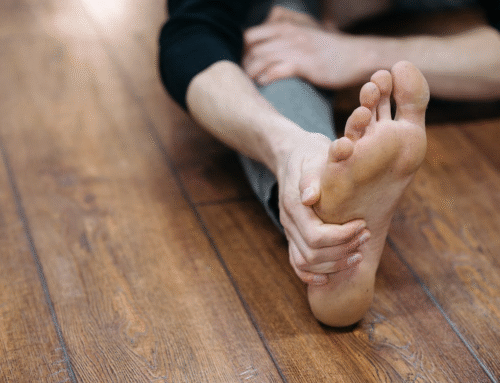There is no difference between toenail fungus vs. onychomycosis. The two terms are synonyms. Toenail fungus is the more common name for onychomycosis. Sometimes people have a difficult time differentiating between the scientific name for something and the name they hear more regularly. If someone said they had a fever, you would know what they were talking about. This is why people usually call onychomycosis by the simpler name of nail fungus. Most people find it easier to communicate in a simpler language.
Residents of Laguna Hills, CA, are no strangers to the discomfort of toenail fungus, especially given the warm climate that encourages sandal-wearing year-round. Being active outdoors, going to the beach, or using community fitness centers can increase exposure to environments where fungus thrives. Seeking treatment locally ensures fast, convenient access to experienced podiatrists who can address the infection effectively while helping patients continue their active, sunny lifestyle without interruption.

Why Treat Toenail Fungus Early?
Toenail fungus is contagious and can spread from one nail to another or even to other people. Early treatment is crucial to prevent the infection from worsening. If left untreated, the fungus can make your nails thick, brittle, discolored, and painful. Understanding the infection and seeking professional care is the best way to stop it.
Who Can Get Toenail Fungus?
Many people mistakenly believe that only older adults or those with weakened immune systems can get toenail fungus. In reality, anyone can be infected—males, females, athletes, and non-athletes alike. Risk factors include injuries to the nail, excessive moisture from sweat, visits to nail salons, and underlying health conditions like diabetes or autoimmune disorders.
Types of Nail Fungus
There are four main types of nail fungus, each with unique characteristics:
-
Distal Subungual Onychomycosis (DSO) – The most common type, starting under the nail and progressing upward. Nails may become yellow, thickened, and crumbly.
-
White Superficial Onychomycosis (WSO) – Affects the top layer of the nail, creating white spots. The nail usually remains intact.
-
Candida Onychomycosis – Caused by yeast, affecting nails and surrounding skin. Nails may discolor, weaken, or separate from the nail bed.
-
Proximal Subungual Onychomycosis (PSO) – Often seen in patients with HIV, beginning near the cuticle and causing the nail to separate from the nail bed.
Recognizing the type of nail fungus is important for choosing the most effective treatment.
Laser Treatment for Toenail Fungus
If you have toenail fungus, the FDA-approved PinPointe laser is a highly effective treatment option. Unlike topical solutions or oral medications, which have lower cure rates or may cause side effects, the PinPointe laser treats the fungus directly under the nail without harming surrounding tissue.
-
Cure rate: Highest among all treatment options
-
Side effects: None
-
Pain: Minimal to none
-
Recovery: No downtime; resume normal activities immediately
During a consultation, our Laguna Hills nail doctor will examine your nails and discuss a personalized treatment plan. Most patients require only one laser session for effective results.
Post-Treatment Care
Even after treatment, it’s important to protect your nails from reinfection. This includes:
-
Keeping feet clean and dry
-
Avoiding shared shoes or nail tools
-
Using antifungal creams if recommended by your doctor
-
Regularly monitoring nails for early signs of reinfection
With proper care, your nails can grow back healthy, clear, and strong, usually within 6–9 months.
When to See a Specialist
If you notice yellowing, thickening, crumbling, or separation of your nails, it’s time to consult a podiatrist. Early intervention increases treatment success and reduces the risk of spreading the fungus.
At our Laguna Hills, CA clinic, we provide expert diagnosis and laser treatment for toenail fungus. The PinPointe laser is safe, effective, and provides lasting results.
Call us today at 1-800-672-0625 to schedule a consultation or visit our website to learn more about our experienced nail doctors at one of our over 150 locations.
Fun Things to Do in Laguna Hills, CA
If you are visiting the wonderful city of Laguna Hills, California, you will have a marvelous time. This city has so much to offer and then some. Your friends and family will have the best time while here.
The city of Laguna Hills is quiet and scenic. This city in Orange County makes it a great adventure for exploring Southern California. If you are an outdoor enthusiast, you will definitely enjoy Aliso & Wood Canyons Wilderness Park. It is a rugged natural preserve with hiking trails, biking trails, and horseback riding trails, along with unique fossil beds. Nearby, Laguna Niguel Regional Park offers open green spaces, picnic areas, and family-friendly recreation. Another area to visit is the Niguel Botanical Preserve. It provides a tranquil setting for a peaceful walk through landscaped gardens. Locals and visitors alike also enjoy the Laguna Hills Farmers Market. It is a great spot to pick up fresh produce and artisan goods while connecting with the community.
If you enjoy the beaches and ocean views, then Laguna Hills is the city for you. Just a short drive west, the coast opens up with all the beauty of Laguna Beach, where you can explore sandy coves, tide pools, and art galleries. Or you can visit the Laguna Art Museum to experience California-inspired exhibitions. Depending on the season, events like the Sawdust Art Festival bring local creativity to life with art, crafts, and performances. These are activities you can enjoy with your family when you visit the area of Laguna Beach.
For those who enjoy shopping and dining, the upcoming Village at Laguna Hills is transforming the former mall site into a lively hub of restaurants, retail, and entertainment. And if you’re up for a bigger adventure, world-famous destinations like Disneyland, Knott’s Berry Farm, and whale watching tours in Newport Beach are all within easy reach, making Laguna Hills a perfectly situated gateway to both natural beauty and iconic attractions.
Beyond its outdoor adventures and coastal proximity, Laguna Hills also has a strong sense of community. The city offers a wide range of classes and activities through its community programs. It offers classes like fitness and dance to art and music, making it easy for residents and visitors to get involved. With its balance of suburban charm, access to nature, and closeness to world-renowned attractions, Laguna Hills is both a relaxing home base and a convenient launching point for discovering the best of Orange County and beyond. Your family can have the best adventures here or the most relaxing time; Laguna Hills has it all.
Schedule a Consultation
If you notice signs of toenail fungus in Laguna Hills, CA, take action today. Our podiatrists offer the PinPointe laser treatment to safely and effectively eliminate toenail fungus. Call us at (800) 672-0625 or visit our website to schedule a free consultation at a nearby location.




